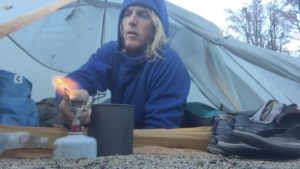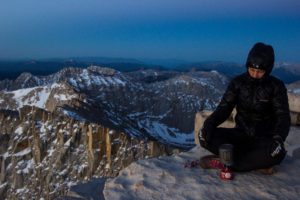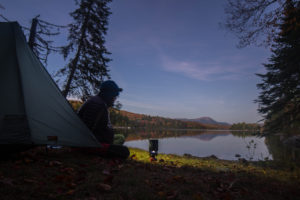
Looking for the right backpacking stove? Where do you plan on doing most of your hiking? What’s the environment like? Are you just cooking for yourself or for a group? How much weight are you willing to carry? Are you patient or do you require a quick cook time? These are all questions you need to ask yourself when looking for the right backpacking stove. So let’s jump right in and take a look at the best backpacking stoves of 2020.
Huge Spring Sale on gear. Check out the link below! (Free Shipping over $40 + no sales tax!)
USOUTDOOR.com Sale! Save up to 70% off Outdoor Gear & Apparel
How to Choose the Right Backpacking Stove
Backpacking stoves fall into 3 main categories:
Isobutane Canister Stoves – These types of stoves are best for solo cooking and longer backpacks or thru-hikes due to its weight and convenience.
Alcohol Stoves – These types of stoves are very light and simple. Old school backpackers may say this is the preferred choice among thru-hikers, but the canister stoves have clearly taken over these days. Although, they are still cheap to buy or make and it weighs close to nothing.
Liquid Fuel Stoves – These are best for group cooking, cold weather use, and international travel.
When choosing a backpacking stove, remember to consider:
- The stoves weight.
- The availability and cost of the fuel to run it
- Whether it’s for individual or group use
- The operating temperatures at which it must perform

| Make / Model | Type | Weight | |
|---|---|---|---|
| MSR Pocket Rocket 2 | Canister Stove | 2.6 oz | |
| Jetboil Flash | Canister Stove System | 13.1 oz | |
| MSR Windburner | Canister Stove System | 15.5 oz | |
| MSR Pocket Rocket Deluxe | Canister Stove | 2.9 oz | |
| Primus Lite+ | Canister Stove System | 12.3 oz | |
| Jetboil Minimo | Canister Stove System | 14 oz | |
| MSR Whisperlite Universal | Canister & White Gas Stove | 13.7 oz | |
| Snow Peak Gigapower | Canister Stove | 3,2 oz | |
| Primus Omni Fuel | White Gas Stove | 15.9 oz | |
| Etekcity Orange | Canister Stove | 3.4 oz |
1. MSR Pocket Rocket 2
The MSR Pocket Rocket 2 is compatible with all screw-type isobutane canisters. Compact and lightweight, it weighs 2.6 ounces and includes a built-in pot stand that’s compatible with a wide range of pots. When not in use, the arms of the pot stand fold down and fit into a small protective plastic case. The adjustable flame control is easy to use while wearing gloves and provides fine-grained control from a rolling boil to a slow simmer. The nice thing about buying a standalone stove like the Pocket Rocket 2 is that you can use it with several different best-of-breed pots and pans, instead of being locked into a single all-in-one stove and pot combination.
Check out my full review on the Pocket Rocket 2 here.
2. Jetboil Flash
The Jetboil Flash is a fully integrated personal cook system that includes a stove, insulated pot w/lid, stove stand, and a plastic measuring cup/bowl. It’s designed to do one thing incredibly well, which is to rapidly boil water for drinks and to rehydrate backpacking/camping meals. Weighing 13.1 ounces, the Flash can boil a liter of water in 4 minutes and 30 seconds (although it can only boil a half liter at a time). A push-button ignition system eliminates the need to light the stove while a color change indicator on the outside of the pot insulation cover lets you know when your water is hot. When not in use, the stove, stand and a 100 g gas canister fit inside the cookpot, making it easy to pack. Check out my full review of the Flash here.
VIEW AT AMAZON VIEW AT ACADEMY SPORTS
3. MSR Windburner
The MSR Windburner is another complete canister stove system that includes an insulated cook pot, stove, stabilizer, and plastic mug/bowl. The thing that sets it apart from the Jetboil Flash is its flame-less stove, wind resistance, and fuel efficiency. Called a radiant burner, it uses a completely enclosed heating element with an internal pressure regulator that makes the stove virtually impervious to outside conditions. Weighing 15.5 ounces, the Windburner can boil a liter of water in 4 minutes and 30 seconds and is nearly twice as efficient as a Jetboil, so you get twice as many boils per gas canister. When it’s time to go, the Windburner stove system packs up into its cook pot, with space for a 110 g gas canister.
VIEW AT AMAZON
4. MSR Pocket Rocket Deluxe
The MSR Pocket Rocket Deluxe Ultralight Camping Stove is an ultralight-backpacking stove with premium features that allow it to perform very efficiently and effectively. It features a pressure regulator that makes it ideal for all-condition environments, offering consistently faster boil times than non-regulated canister-mounted stoves. The trusted choice of alpinists and campers, for its durability and reliability, it’s easy to set up and operate—no priming, preheating, pumping, or pressurizing is required—and boils one liter of water in just 3.5 minutes. Just a smidge heavier than the PocketRocket 2 stove, this ultralight deluxe version features a push-start Piezo Igniter that’s fast and reliable because the spark igniter is protected inside the burner for maximum durability. Simmer or boil, and adjust the flame anywhere in between for temperature-controlled gourmet cooking in the outdoors.
VIEW AT AMAZON
5. Jetboil Minimo
The Jetboil MiniMo is a fully integrated personal cook system that includes a stove, insulated pot w/lid, stand, and a plastic measuring cup/bowl. It’s different from the Jetboil Flash because it’s designed to simmer meals in addition to boiling water, so you can cook gourmet meals on the trail or in camp. It also has a shorter and wider pot that’s easier to eat out of than the Flash. Weighing 14 ounces, the MiniMo can boil a liter of water in 4 minutes 30 seconds (although it can only boil a half liter at a time) and has a burn time of one hour on a 100 g gas canister. A push button ignition system eliminates the need to light the stove. When not in use, the stove, stand, measuring cup, and a 100 g gas canister fit inside the insulated cook pot, making the MiniMo easy to pack.
6. Primus Lite+
The Primus Lite+ is a compact all-in-one stove system; the stove, accessories, and a 100 gram gas cartridge (not included) conveniently store inside the 500 ml hard anodized aluminum pot. With a lower center of gravity because of their low-profile Laminar Flow Burner Technology™ – the Lite+ is more stable, lighter and more compact than the other system stoves on the market. Perfect for solo trips or coffee break for two, the optional coffee press makes two cups of fresh coffee in minutes!
VIEW AT AMAZON
7. MSR Whisperlite Universal
The MSR Whisperlite Universal burns a variety of fuels including white gas, kerosene, unleaded gasoline and isobutane-propane canisters giving you lots of flexibility no matter where you find yourself. Just switch the fuel line and select one of 3 self-cleaning Shaker jets, depending on the fuel type required. When burning white gas, the Universal can boil a liter of water in 3 minutes 30 seconds while it takes 3 minutes 45 seconds with an isobutane canister. Simmering is possible with all fuel types as well as a roiling boil, while the remote burner makes it possible to use a windscreen, no matter what type of fuel is used. In addition to the stove, the 13.7 oz Whisperlite Universal includes a fuel pump, windscreen, heat reflector, and small parts kit.
VIEW AT AMAZON VIEW AT USOUTDOORS
8. Snowpeak Gigapower
The Snow Peak GigaPower auto is a standalone isobutane canister stove that can simmer or boil water. It has four pot supports that are compatible with a wide variety of cook pots, as well as a built-in piezo ignition system for matchless ignition. A solid and reliable performer, this 10,000 BTU stove weighs 3.2 ounces and takes an average of 4 minutes 45 seconds to boil a liter of water. While it comes with a protective plastic case, it can also be stored in a variety of cook pots with a gas canister. An add-on windscreen is also available to boost its impressive fuel efficiency.
9. Primus Omni Fuel
Primus OmniFuel is tried and true. It has been tested extensively over many years and has been used on countless expeditions. Their most award-winning stove comes with both a fuel bottle (note that the fuel bottle does not come with fuel) and an ErgoPump. This stove has an output of 3000W / 10500 BTU/h, and will last for 70 minutes on 230 g (8.1 oz) gas cartridge. This complete set also includes a multi-tool with a cleaning needle, a windscreen, and a heat reflector. OmniFuel is an excellent item for your backpacking adventures or expeditions.
10. Etekcity Orange
The Etekcity “Orange” stove is a popular budget canister stove that’s good enough for beginners and scouts. It’s a bit of a cult classic, known for its inexpensive price as well as the orange pocket-sized plastic case that’s included to protect the stove in transport. Weighing 3 and 3/8 ounces, it’s not the lightest weight canister available or the most powerful (6666 BTU), but it’s compatible with all screw-type isobutane canisters and can boil water or simmer meals just like the name brand canister stoves listed above. It has a built-in, fold-away pot stand with serrated feet as well as a piezo igniter for push-button ignition. It even comes with a 1-year warranty.

Stove and Cooking Fuel Types
There are 5 main types of backpacking stoves:
White Gas Stoves
These burn a refined form of unleaded gas (liquid gas). Ideal for group and winter cooking because of the amount of heat they produce. However, they tend to be a bit bulky so I typically only use mine during the winter or if I plan on cooking at extremely high altitudes. If you plan on doing a lot of cooking or melting snow, these bad boys are the way to go. These use to be a lot more popular back in the day, but compared to the others out there on the market, these tend to be a lot bulkier, heavier and noisier. Although, if you’re cooking for a large group of people or doing some hiking internationally, you can’t go wrong.
Liquid Stove Summary
PROS
- Fuel is less expensive
- Fuel bottles are refillable and easier to gauge usage
- Great for melting snow in extreme cold conditions
- Can be better for international travel
CONS
- Heavy and bulky
- More expensive – have to buys accessories
- More complicated to use
- Can be dangerous (spilling fuel)
- Requires more maintenance
- Noisier than others
Canister Stoves
These require an iso-butane/propane mix and are best used for individual use or couples anywhere from day hikes to thru-hikes. They can simmer, but their main purpose is to boil your water (for rehydrating). In my personal opinion, these are the way to go for a 3-season backpacking stove. They are super convenient to use, the boil time is extremely fast and it doesn’t ruin your pot, as well as the gear it touches, due to the residue left over like other types of stoves. The fuel is slightly more expensive than some options. Although, these fuel canisters are beginning to appear in more and more places, you may still have a difficult time finding it if you’re traveling internationally. And keep in mind, these aren’t the best stoves for winter use or at higher elevations (13,000+ ft.).
Canister Stove Summary
PROS
- Light & compact
- Rapid boil times
- Easy to use
- Clean burn (no smell or residue)
CONS
- Slightly more expensive fuel
- Can be harder to find fuel internationally
- Not as good as liquid fuel stoves in extreme cold
Alcohol stoves
These use denatured alcohol and are very simple to use, as well as the main choice among old-school backpackers. Although, they are definitely still being used out there and the price/weight/fuel availability ratio is hard to beat. They are super light and compact, as well as cheap and easy to make. You’ll be able to find this type of fuel in just about any supermarket, drugstore or hardware store. Keep in mind these aren’t the fastest cooking stoves out there, so you may need a bit more patience. I also find these difficult to use on windy days, and they definitely aren’t ideal for winter trips.
Alcohol Stove Summary
PROS
- Light and compact
- Inexpensive
- Easy to make
- Easy to find fuel
- Very quiet
CONS
- Slow cooking times
- Less efficient fuel
- Poor performance in wind
- No temperature control
- Can be dangerous (difficult to see flame and spills)
- Can’t use during most fire bans
- Not good for winter trips
Wood stoves
These simply used twigs and small sticks and can be convenient if natural fuel is easily available, but fire bans in drier areas often prohibit their use. The best part is that it’s cheaper to use and the fuel is basically free. It does have a bit of a learning curve compared to other stoves out there, but with a bit more time, effort and practice you’ll get the hang of it. They are a bit heavy and they do take longer to cook with, but there is something about cooking the old fashion way that gives you a good feeling. Beware of the residue left behind on your pot due to the flames.
Wood Stove Summary
PROS
- Minimal fuel weight
- Minimal fuel cost
- Renewable fuel resource
CONS
- More time, effort, and practice required
- Slower cook times
- Usually heavier
- Hard to find fuel when wet or above tree line
- Blackens the bottom of your pot (messy)
- Can’t use during fire bans
- Not good for winter trips
Solid fuel stoves
Solid fuel stoves burn prepackaged fuel cubes which are very lightweight, but the fuel can be difficult to find during a resupply on longer trips in isolated areas. The fuel itself is a bit expensive, but it is super light and compact. You don’t have to worry about any liquid spillages or empty canisters to pack out. It’s extremely quiet and easy to use. It does require a bit more time to cook with and it’s not ideal in windy conditions. These don’t offer any type of temperature control and it does leave behind and unpleasant odor while cooking. I also wouldn’t recommend this on winter trips.
Solid Fuel Stove Summary
PROS
- Light and compact
- Inexpensive stove
- Easy to make and use
- Very quiet
- No fuel spilling
CONS
- Slow cooking times
- Expensive fuel
- Poor performance in wind
- No temperature control
- Residue left on pot
- Unpleasant odor
- Can be tough to resupply fuel
- Not good for winter trips
More Information
I hope you found this review helpful. Below are a few other resources you may find helpful from The Epic Reviews.
- 10 Best Backpacking Water Filters of 2020
- Top 5 Backpacking Tents of 2020
- Dow vs. Synthetic Sleeping Bags: Which is Right for You
- Osprey Atmos AG Series: The Backpack That Can Do It All
If you have any questions on any of the topics I cover, please drop me a line in the comment section below and I will be happy to bring the information to you. Be smart, stay safe and get out there and crush some miles!
*Editor’s note: Help support this site by making your next gear purchase through one of the links above. Click a link, buy what you need, and the seller will contribute a portion of the purchase price to support TheEpicReviews unsponsored gear reviews, articles, and hiking guides.










